Asking “what premium dovetail saw should I buy?” is rather like asking “what fancy bra should I buy?” There are so many things to consider in either instance that there’s no easy answer. The best determinant – though not always easy to achieve – is to try all of them that appeal before making a final choice and plunking down your money. It comes down to which one fits you best – and one that’s a good fit for you is unlikely to be my first choice (unless you also have very small hands … I’m talking about the saws here, of course).
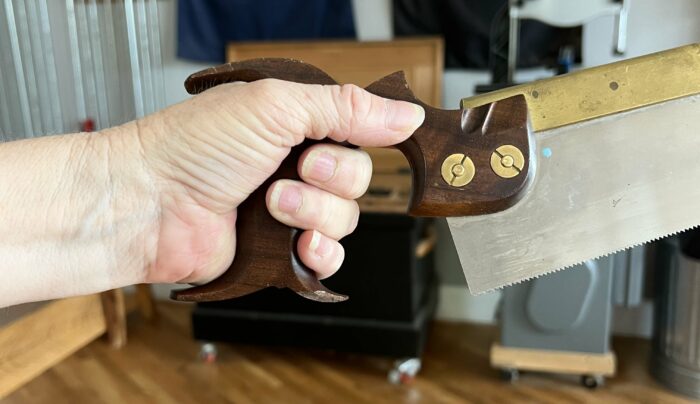
Get hands-on
Hands down, the “best” commercial dovetail saw that I’ve tried – FOR ME – is the Bad Axe, but only because one has a choice of handle sizes (I am the hand model for the extra-small, so of course it fits me well). Some other makers, Skelton Saws to name one, offer custom handles, but as far as I know only Bad Axe offers different handle sizes as a standard option. And because I use my saw a lot (and sometimes have to look like I know what I’m doing while using it), I want a handle that fits my hand perfectly, so I don’t slide around on it, or have to grip too hard to keep the blade pointed where I want it.
Most handles are sized to the “average” woodworker’s hands. And that means men (though I do think that’s changing, and I hope more toolmakers start to take that into consideration for tools where the size makes a substantive difference). And some even offer “regular” and “large” (both are, again, based off a typical XY hand).
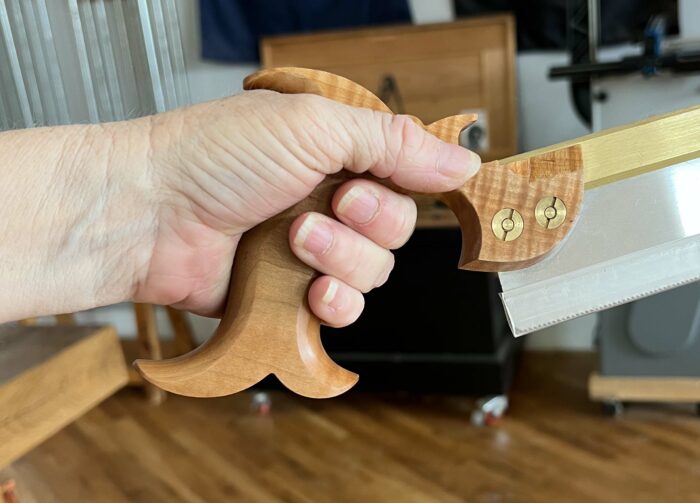
Let it hang
But what else goes into choosing a dovetail saw, and how much does it matter?
Handle size aside, the first thing I’d consider is the hang. “Hang” refers to how the handle sits in relation to the blade – and in the pictures just above, you can see that my thumb is pointing at more of a downward angle; that saw has a higher hang than the walnut-handled one. The difference is even more obvious from the other side, where you can see how my index finger is pointed. Many people swear by a hang that ends up pointing your index finger toward the middle of the saw plate.
The lower hang on my saw means in theory that I have to push harder to make the cut. But another factor, the saw’s weight, also affects the cut – and extra weight on my Bad Axe vs. the Lie-Nielsen that Christopher Schwarz uses most often is 14.7 oz. vs. 12.5 oz. That additional weight counterbalances the low hang for an easy-to-make-cut.
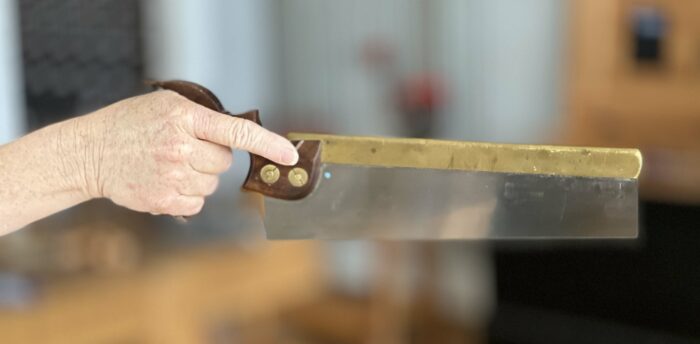
Weight distribution
Part of that weight is in the folded brass back, but the BA saw plate is also thicker than the LN – .018 in. vs. .015. If I were the only one using the saw, I’d prefer a thinner plate (less steel, so a little easier to push). But the thinner the plate, the easier it is to bend – and I hand mine out to students to try, which is just asking for trouble. That .003 in. could be the difference between a kink and not.
Speaking of backs (aka the spine), some are folded over and pinch the sawplate; other backs have a groove into which the plate is inserted and glued. The folded ones are easier to fix, but in my experience they do require fixing. Even so, I like a folded back – I guess because it’s traditional. (I have to sometimes smack the spine down hard on my bench to reseat the plate on my 15-year-old saw. It’s fun to do in front of people; it always elicits gasps and winces.)

Also on the subject of weight: I like a little bit of heft in a saw, but there’s one that, at 20 oz., just makes me want to take a nap. (The extra weight comes from a heavier back, handle, and thicker sawplate). To that maker, the additional weight is a benefit. And he has cut more dovetails than probably anyone, so I’m not saying he’s wrong. It’s just wrong for me.
Hang and where the center of gravity is on the saw might also play into whether you prefer a tapered or non-tapered sawplate. A tapered plate is a traditional 18th-century look, but it also takes a little weight off the toe. And I’ve heard folks argue that the slightly less weighty toe means it’s easier to hit the baseline on both sides of the work simultaneously.
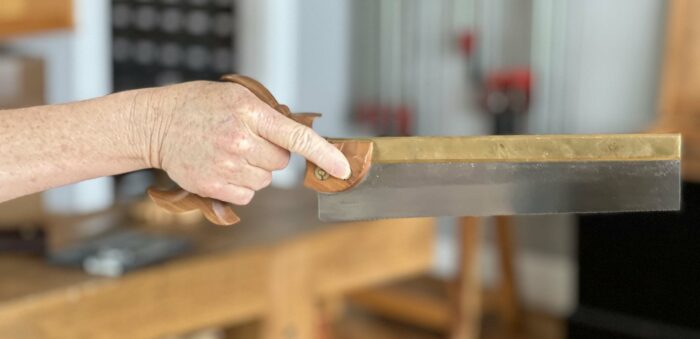
Don’t forget the teeth
You might also consider the teeth, which will be measured in either ppi (points per inch, or the pointy bit at the top of the teeth) or tpi (teeth per inch, or the number of full teeth per inch); 16 ppi is about the same as 15 tpi. If you’re using your saw for both casework and drawers (that is, both thicker stock and thinner stock), I’d go for something in about that range (I cut far more casework than drawers). But if all I cut was thin stock, I’d probably go for 18 to 20 ppi/tpi. The more teeth the slower the cut, but it will be cleaner and easier to start. (And I’d go for a thinner plate along with more teeth.)
I used to have a Gramercy dovetail saw that was perfect (other than the large handle) for thin stock: 19 tpi, thin plate. But I so rarely used it because most of my work is in 3/4-in. or 7/8-in.-thick stock – so I sold it. (In hindsight, I should have kept it; it would have come in handy for the more delicate dovetails I cut on tool chest tills.) A few makers, Veritas among them, offer a tpi choice (and at the price there, both are affordable!).
What holds it all together
And now I’m getting into what some might consider the weeds, but take a moment to look at the bit of brass or steel that in most cases holds the handle on to the sawplate: You’ll note that most are split nuts, which not only require a special driver, but are a lot easier to strip (when, say, tightening them in the case of a loose handle) than sex nuts that use a straight driver. So why doesn’t everyone use sex nuts? Well they’re not traditional. But I’m not a sawmaker, so maybe there’s a better reason. (But I doubt it).
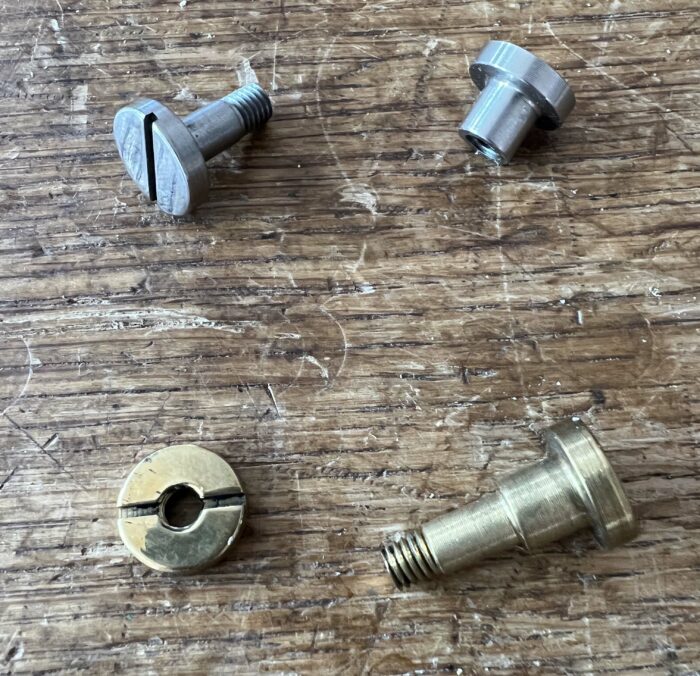
In the end, it really comes down to what feels best in your hand, or, barring that, what looks good to you and meets the specifications you’ve decided are important to you. Or what someone has convinced you is important. But it also comes down to familiarity: Whatever you get used to is a good saw for you. Sawing dovetails with someone else’s saw feels like wearing someone else’s bra. It might do its job, but it feels all wrong.

More by Megan Fitzpatrick








